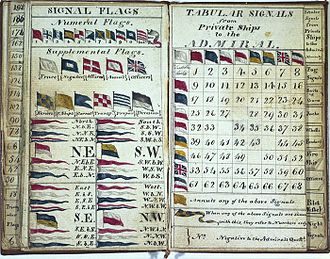Marryat signal code
The Marryat's Code of Signals was a system of flag signals introduced in 1817 by the English naval officer Frederick Marryat . It was initially used to signal and detect merchant ships over long distances at sea.
In the Marryat Code there was a flag for each of the digits 0 to 9, determined by shape and color, as well as individual group pennants that varied the meaning of the numbered flags.
Each ship was assigned a four-digit number between 1 and 9876 as well as one of the two (first) groups, whereby no digit was contained twice in the individual ship number. In the event of a signal, the individual ship hoisted its group flag one on top of the other and underneath it, one after the other, the digit flags for the assigned number.
Shipowners who wanted to participate in the signaling system had to join the Marryat organization and were then given the extensive code books.
In order to have enough leeway in terms of quantity, there were initially two groups with which a total of 19,752 ships could be recorded. Later, parallel to the two number groups for merchant ships, other groups for British and non-British warships, a number group for lighthouses, ports and other geographical locations, and a number group for standardized message rates were introduced.
With the group pennant placed at the top for geographical locations and their number flags, for example, a ship could signal its origin, while a destination port was indicated by the position of the same group pennant at the bottom.
The system was renamed The Universal Code of Signals for the Mercantile Marine of All Nations in 1854 and was in use until around 1890, mostly on British, American and German ships. The last update of the associated code books took place in 1879. It was then replaced by the international flag alphabet .
literature
- Wolfgang Walter: Downeasters and Nova Scotians. American and Canadian sailors from the Weser. Convent Verlag, Hamburg 2003, ISBN 3-551-88517-6 , p. 116ff. ( Writings of the German Maritime Museum 59).
Web links
- Image representation of the flag system in the English language Wikipedia
- Flags flags info
- Different flag signal systems
